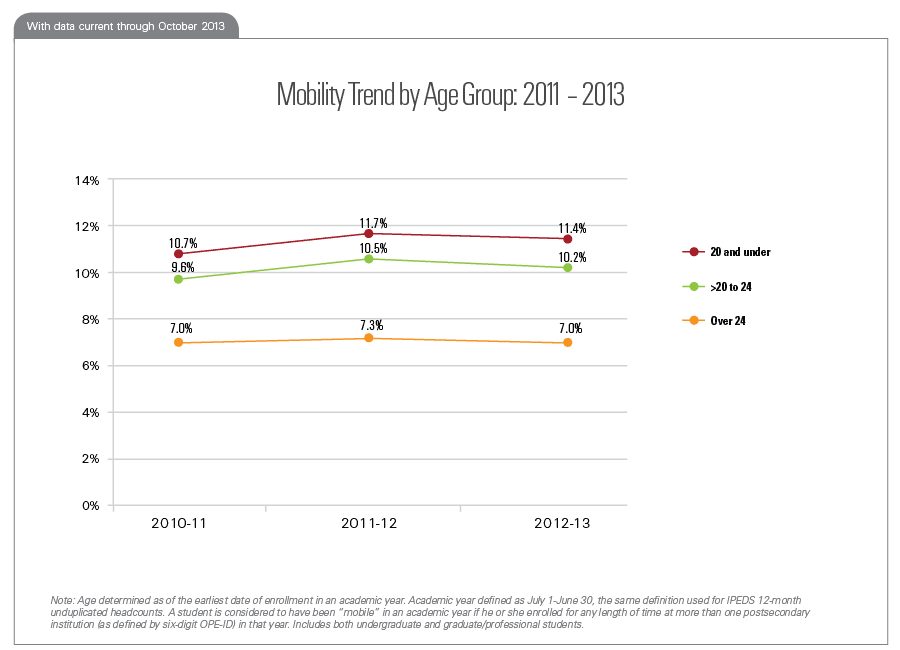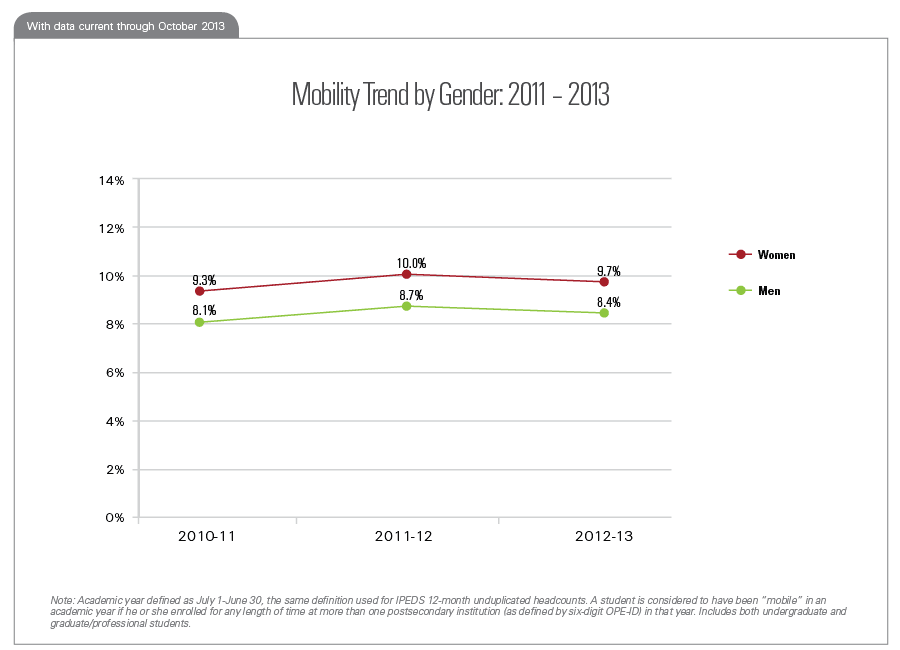Postsecondary Student Mobility Rate: 2011-2013
Just over 9% of all students attended more than one institution during the 2012-13 academic year. Overall, student mobility rates increased from 2010-11 to 2011-12, and then stabilized in 2012-13.
Student Mobility Rate Stabilizes
The postsecondary student mobility rate is the percentage of students, across all levels of study, who enrolled in more than one institution in a single academic year (including summer and concurrent enrollments.) It provides a current indicator of the prevalence of multi-institutional student pathways.
Overall, student mobility rates increased from 2010-11 to 2011-12, and then stabilized in 2012-13.
In each year studied, the mobility rate was highest for students who began an academic year in a 2-year public institution. Among students whose first 2012-13 enrollment occurred at a community college, 11.5% had also enrolled somewhere else by the end of the academic year.

Note: Academic year defined as July 1-June 30, the same definition used for IPEDS 12-month unduplicated headcounts. A student is considered to have been “mobile” in an academic year if he or she enrolled for any length of time at more than one postsecondary institution (as defined by six-digit OPE-ID) in that year. Includes both undergraduate and graduate/professional students. Two-year, for-profit and two-year private, nonprofit institutions are not shown in the table due to small counts, but those sectors are included in the trendline for “All Sectors.”
Community Colleges Play Important Role in Student Mobility
In each year studied, nearly three-fourths of all mobile students had at least one enrollment at a 2-year public institution. Of all students who attended multiple institutions in 2012-13, nearly 40% moved between 2-year public institutions and 4-year public institutions (in either direction). Over the three years studied, the share of mobility accounted for by student swirl among 2-year public institutions diminished slightly from 18.7% to 17.4%.

Note: Academic year defined as July 1-June 30, the same definition used for IPEDS 12-month unduplicated headcounts. A student is considered to have been “mobile” in an academic year if he or she enrolled for any length of time at more than one postsecondary institution (as defined by six-digit OPE-ID) in that year. Includes both undergraduate and graduate/professional students.
Mobility Rates Higher for Younger Students
In each of the included years, students in the 20 and under age group had the highest mobility rates, followed by students in the >20 to 24 age group. Student mobility rates have implications for enrollment management and education policy, raising the stakes around issues such as academic advising and evaluation of transfer credits.

Note: Age determined as of the earliest date of enrollment in an academic year. Academic year defined as July 1-June 30, the same definition used for IPEDS 12-month unduplicated headcounts. A student is considered to have been “mobile” in an academic year if he or she enrolled for any length of time at more than one postsecondary institution (as defined by six-digit OPE-ID) in that year. Includes both undergraduate and graduate/professional students.
Mobility Rates Higher Among Women Than Men
In each of the years studied, the percentage of women attending more than one institution within a single year was one and a quarter percentage points higher than the rate for men.

Note: Academic year defined as July 1-June 30, the same definition used for IPEDS 12-month unduplicated headcounts. A student is considered to have been “mobile” in an academic year if he or she enrolled for any length of time at more than one postsecondary institution (as defined by six-digit OPE-ID) in that year. Includes both undergraduate and graduate/professional students.
Data analysis performed by Jason DeWitt, Research Manager, Jill Indugula, Research Analyst and Vijaya Sampath, Sr. Programmer & Research Associate.

